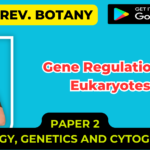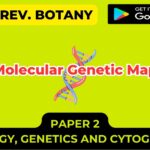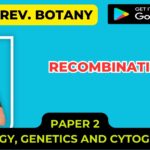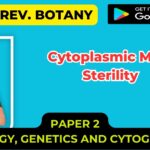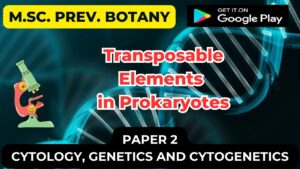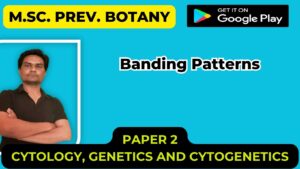Genetics of Mitochondria and Chloroplasts
- Mendel’s principles of segregation and independent assortment are based on the assumption that genes are located on chromosomes in the nucleus of the cell.
- For the majority of genetic characteristics, this assumption is valid, and Mendel’s principles allow us to predict the types of offspring that will be produced in a genetic cross.
- However, not all the genetic material of a cell is found in the nucleus; some characteristics are encoded by genes located in the cytoplasm.
- These characteristics exhibit cytoplasmic inheritance. A few organelles, notably chloroplasts and mitochondria, contain DNA.
- Each human mitochondrion contains about 15,000 nucleotides of DNA, encoding 37 genes. Compared with that of nuclear DNA, which contains some 3 billion nucleotides encoding perhaps 35,000 genes, the amount of mitochondrial DNA (mtDNA) is very small; nevertheless, mitochondrial and chloroplast genes encode some important characteristics.
- Cytoplasmic inheritance differs from the inheritance of characteristics encoded by nuclear genes in several important respects.
- A zygote inherits nuclear genes from both parents, but typically all of its cytoplasmic organelles, and thus all its cytoplasmic genes, come from only one of the gametes, usually the egg.
- Sperm generally contributes only a set of nuclear genes from the male parent. In a few organisms, cytoplasmic genes are inherited from the male parent, or from both parents; however, for most organisms, all the cytoplasm is inherited from the egg.
- In this case, cytoplasmically inherited maits are present in both males and females and are passed from mother to offspring, never from father to offspring.
- Reciprocal crosses, therefore, give different results when cytoplasmic genes encode a trait.
- Cytoplasmically inherited characteristics frequently exhibit extensive phenotypic variation, because there is no mechanism analogous to mitosis or meiosis to ensure that cytoplasmic genes are evenly distributed in cell division.
- Thus, different cells and individuals will contain various proportions of cytoplasmic genes.
Consider mitochondrial genes.
- There are thousands of mitochondria in each cell, and each mitochondrion contains from 2 to 10 copies of mtDNA.
- Suppose that half of the mitochondria in a cell contain a normal wild-type copy of mtDNA and the other half contain a mutated copy (Figure 2.17).
- In cell division, the mitochondria segregate into progeny cells at random.
- Just by chance, one cell may receive mostly mutated mtDNA and another cell may receive mostly wild-type mtDNA (see Figure 2.17).

- In this way, different progeny from the same mother and even cells within an individual offspring may vary in their phenotype e.g. cytoplasmic inheritance like inheritance of plastids in Mirabilis jalapa.
- Traits encoded by chloroplast DNA (cpDNA) are similarly variable. In 1909, cytoplasmic inheritance was recognized by Carl Correns as one of the first exceptions to Mendel’s principles.
- Correns, one of the biologists who rediscovered Mendel’s work, studied the inheritance of leaf variegation in the four-o’clock plant, Mirabilis jalapa.
- Correns found that the leaves and shoots of one variety of four-o’clock were variegated, displaying a mixture of green and white splotches.
- He also noted that some branches of the variegated strain had all-green leaves; other branches had all white leaves.
- Each branch produced flowers; so Correns was able to cross flowers from variegated, green, and white branches in all combinations (Figure 2.18).
- The seeds from green branches always gave rise to green progeny, no matter whether the pollen was from a green, white, or variegated branch. Similarly, flowers on white branches always produced white progeny.
- Flowers on the variegated branches gave rise to green, white, and variegated progeny, in no particular ratio.

- Corren’s crosses demonstrated cytoplasmic inheritance of variegation in the four-o’clocks.
- The phenotypes of the offspring were determined entirely by the maternal parent, never by the paternal parent (the source of the pollen).
- Furthermore, the production of all three phenotypes by flowers on variegated branches is consistent with the occurrence of cytoplasmic inheritance.
- Variegation in these plants is caused by a defective gene in the cpDNA, which results in a failure to produce the green pigment chlorophyll.
- Cells from green branches contain normal chloroplasts only, cells from white branches contain abnormal chloroplasts only, and cells from variegated branches contain a mixture of normal and abnormal chloroplasts.
- In the flowers from variegated branches, the random segregation of chloroplasts in the course of oogenesis produces some egg cells with normal cpDNA, which develop into green progeny; other egg cells with only abnormal cpDNA develop into white progeny; and, finally, still other egg cells with a mixture of normal and abnormal cpDNA develop into variegated progeny.
- In recent years, a number of human diseases (mostly rare) that exhibit cytoplasmic inheritance have been identified.
- These disorders arise from mutations in mtDNA, most of which occur in genes coding for components of the electron-transport chain, which generates most of the ATP (adenosine triphosphate) in aerobic cellular respiration.
- One such disease is Leber hereditary optic neuropathy.
- Patients who have this disorder experience rapid loss of vision in both eyes, resulting from the death of cells in the optic nerve.
- Loss of vision typically occurs in early adulthood (usually between the ages of 20 and 24), but it can occur any time after adolescence.
- There is much clinical variability in the severity of the disease, even within the same family.
- Leber hereditary optic neuropathy exhibits maternal inheritance: the trait is always passed from mother to child.

